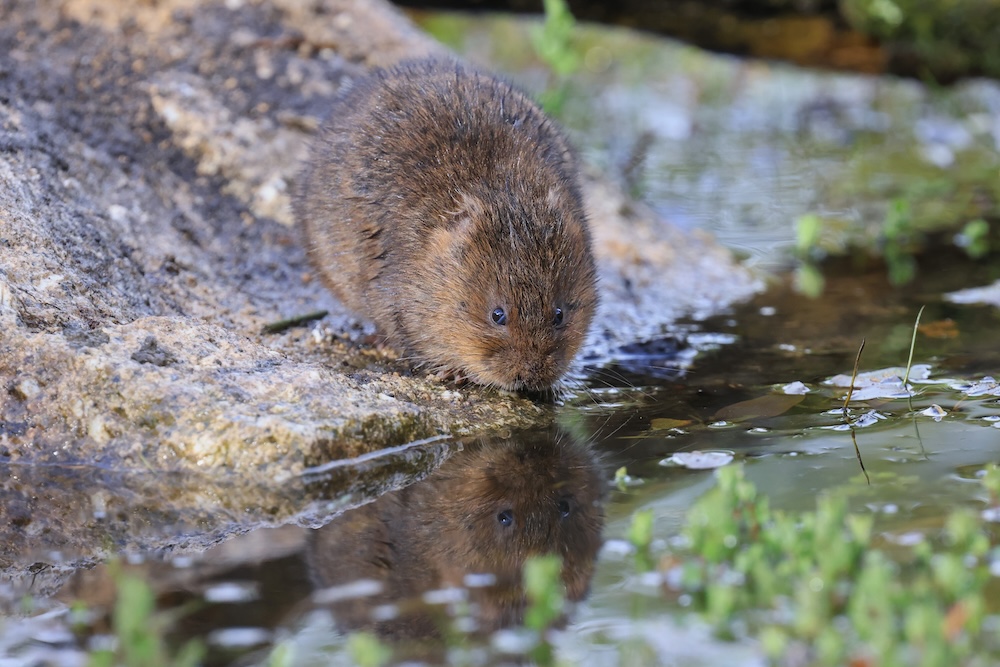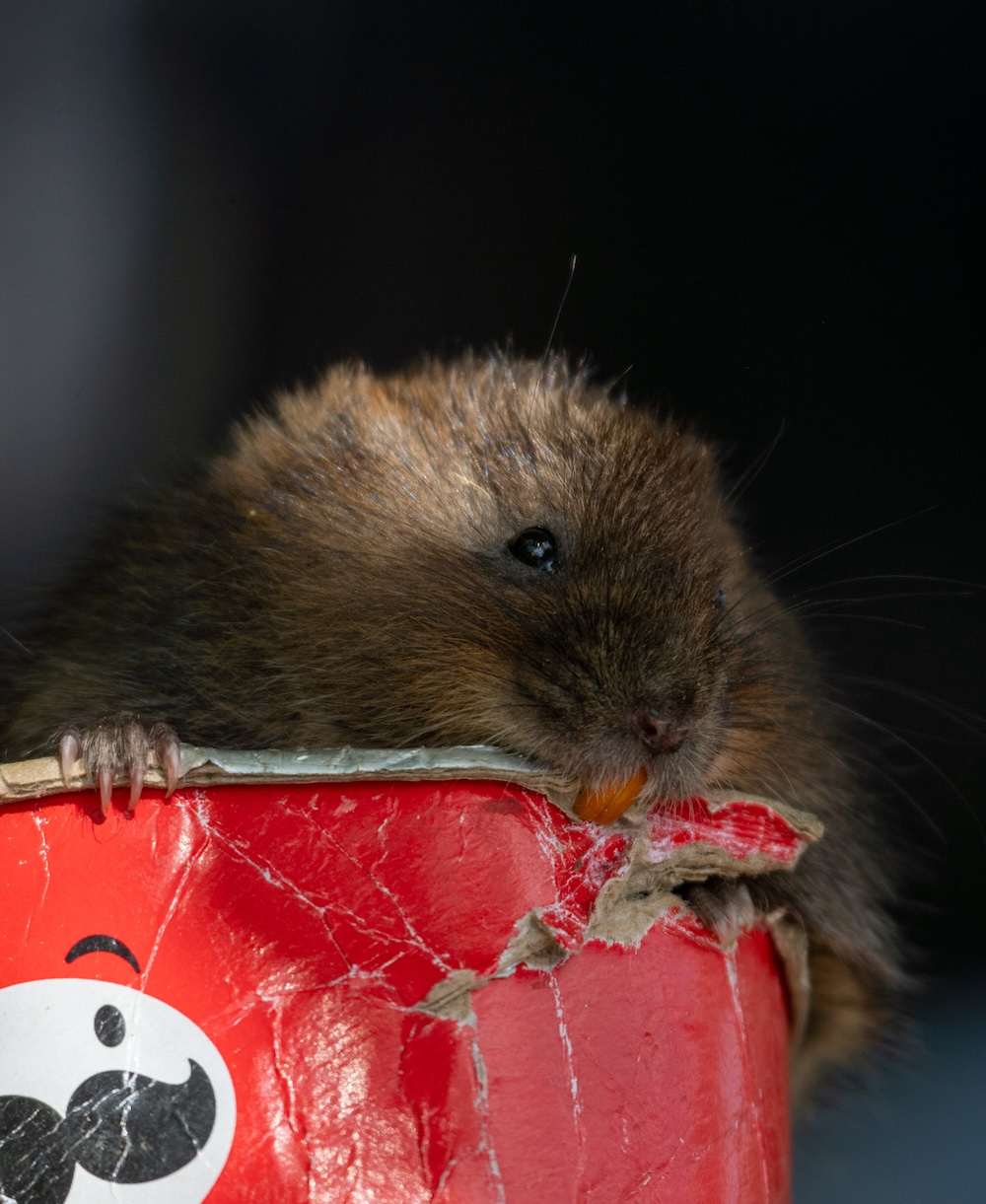Joe Marshall dives into water vole conservation efforts in Cornwall.

Photo by Adrian Lee. All other images: Joe Marshall.
High on a hill above Redruth, in the bank of a clear narrow stream, is a hole the size of a fist. A burrow entrance, dug out by the water voles that have made a home along the River Kennall’s grassy banks that wind through this part of the post-industrial Cornish mining landscape down to the Fal Estuary. This entrance isn’t far from the river’s source, just a few hundred meters. What makes this remarkable is that until recently, no water voles existed in this part of Cornwall; not since the 1990s when they were considered extinct across the whole region.
Generations can measure the decline of the water vole. My father will tell you with glee about his childhood memories, growing up in Wolsingham, County Durham, swimming in the River Wear with his friends at a spot known locally as the Rat Hole. ‘Water rat’, was a name for water voles so commonplace that the character Ratty, from Kenneth Grahame’s classic The Wind in the Willows, was a water vole. The name Rat Hole is one you would think might put kids off swimming but that was far from the case – especially in the post-war pre-public safety days of the 1950s. My father and his friends would spend hours in the summer playing by the river, swimming in the Rat Hole, or hanging out on the bridge watching the water voles scurrying around the banks. The plop-plop-plop of the voles escaping into the river as footsteps approached was as familiar in Weardale as anywhere in England. But my father’s memories of water voles exist only in that short period in his formative years. When the family moved to Newcastle and he subsequently headed south to university and life in the industrial heartland of South Yorkshire, the water voles stayed in Weardale and in the early memories of which he still speaks so vividly.
I have just one childhood memory of a water vole and I’m not even sure if it’s a memory at all. A vague and hazy recollection – a long faded slide in a time-tarnished collection. Sometime in the early 1980s – a Lake District beck, possibly the Glenderamacken or the River Derwent. A furry brown blur slinks into the water; gone from sight in a brief plop. A fragmented memory of a family holiday that somehow formed a foothold in my memory. But it could be false, a conflation of a rodent sighting – perhaps even a rat – and my father retelling his childhood memories by the Wear. He claims no memory of ever seeing one post-leaving Weardale. But for some reason that half memory has always stuck, as childhood sightings of wild creatures would – nothing will create a myth of memory quite so vividly as a sense of wonder.
The following generation would have no water vole memories, false or otherwise. No childhood pastimes of vole ‘hunting’ by the riverbank. Not swimming in ‘rat holes’ or even half-remembered possible sightings on visits to the country. There would be no water voles in this generation’s collective childhood recollections because there would be no water voles for most people to see after a 90% decline across Britain. This is shifting baseline syndrome: the psychological and sociological phenomenon whereby each generation accepts the situation – in this case biodiversity loss – that they are born into as normal.
In 2022, the small community interest company I co-run alongside water vole expert David Carrier — Kernow Conservation — made the first reintroduction in this part of Cornwall at the Trelusback Foundation conservation site on the upper Kennall. Since then, with outside funding and help from volunteers and local businesses, David’s project has made another three reintroductions to the region.
Water voles are ecosystem engineers; herbivorous gorgers of up to 227 plant species, consuming up to 80% of their body weight daily, aiding plant diversity on the riverbanks. Water vole burrow systems dry the soil, enhancing the number and activity of microbes. Without water voles, wetland areas and riverbanks become less biodiverse with more of the same dominating grass species. Water voles are the largest vole species in the UK, weighing up to 350g as adults and providing a vital food source for many native predators. Anything from a pike to a pine marten will eat a water vole and we have witnessed herons and sparrowhawks taking them whole.
Despite once being common in all of Britain, water voles reached the brink of oblivion across much of the country by the end of the last century. The post-war industrialisation of the countryside left little space for nature in its margins, and the canalisation of rivers and urbanisation of river banks have left water vole habitats in a fragmented state. Those fragments that survived in rural river banks found themselves even more precariously balanced. The American mink was first brought to the UK in 1929 to provide material for the fur trade. By the 1950s mink farms were commonplace throughout the country and seen as a relatively low-cost addition to many rural farms – a side hustle, where mink would be kept in small cages on the edge of a farmyard. By the 1960s many had escaped, and in the following decades as public opinion swayed further against the fur trade many mink were released by well-intentioned animal rights activists who unwittingly unleashed hundreds of these highly efficient predators into the British countryside.

Smaller than our native mustelids such as otters and weasels, the American mink is the only predator of the water vole that can fit inside its burrow systems. Once inside it will reap carnage, wiping out entire colonies in hours. But, the American mink is also not immune to shifting baseline syndrome. The evidence we find of them on the ground in Cornwall now is anecdotal – stories of common sightings in people’s back gardens in their younger days, however, those sightings have become rarer over the last 20-30 years. The American mink, persona non grata in the UK, is illegal to release once trapped. Although widespread, it is thought that these outlaw populations are themselves fragmented and once isolated can be controlled – as recent successful trials in East Anglia have shown may be possible. Evidence also suggests that where otter populations have increased the mink has declined.
The burrow system high on the River Kennall represents recovery – despite existing by way of intervention. Although we expected the voles to disperse and establish new territory downstream from the Trelusback Foundation reintroduction site, discovering water voles so far upstream is a welcome surprise. But if that upstream migration is remarkable, what is even more so is the downstream dispersal of the water vole population in the two years since they first arrived. We have found evidence, either in droppings, burrows or camera-trap footage of water voles from close to the source of the Kennall, past fast-moving roadside channels and the cascading rapids of the Kennall Vale Nature Reserve, navigating through the villages of Stithians and Ponsanooth, all the way to the point at which the river becomes tidal just a mile or so from the mud flats of the Fal Estuary and the open sea beyond – an 8km stretch of an almost entire river system where water voles were previously absent.
Regardless of this success, the threat of American mink is ever-present. And despite that, in the several years we have been monitoring and found no evidence of mink in the area, they could move in at any time. One hope is that the water vole population here is so widely dispersed that if mink did appear in the area they could be detected and controlled before they wipe out the whole population. Unfortunately, it takes time, effort and financial investment to monitor that threat.
There are still only water voles in fewer than seven of more than 130 river valleys in Cornwall. But, while baselines shift from one generation to the next in a negative trend, that too, where possible, can still be reversed. Lifting those baselines can be a measure of success, and many organisations like ours are carving their own path through the biodiversity crisis, with more water voles recently released in Cornwall and across the UK.
We believe that targeted, on-the-ground conservation efforts combined with long-term, forward-thinking, and the right funding and collaborative action can make a difference, as the small handful of people involved in our water vole project has shown. And while my generation and the one following may have no concrete memory of water voles, a generation of children in south Cornwall may now encounter one of Britain’s most endangered mammals breaking cover to hit the water with a plop.

*
You can follow Joe on Instagram here.